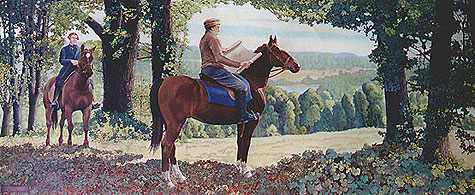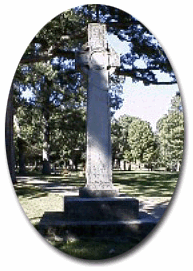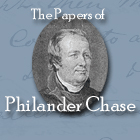"Well, this will do!" explained

"Well, this will do!" is what Bishop Philander Chase said upon reaching the top of Gambier Hill for the first time on July 24, 1825... or so the legend goes.
Bishop Chase originally established Kenyon College on his farm in Worthington, Ohio, a small frontier community to the north of Columbus. Kenyon quickly outgrew Chase's farm, and the village of Worthington was becoming too "urban" for Chase's liking. Thus, he began scouting for a new location. He first chose a site along Alum Creek-- not far from Worthington. However, his plans for this site fell through. Chase then, with the help of Mount Vernon lawyer Henry B. Curtis (pictured above with Chase), selected and purchased 8000 acres of land in Knox County, along Owl Creek (the Kokosing River). In 1859, Curtis told the story to the Kenyon Collegian.
 |
The Prayer Cross, located on on the |
The Bishop and myself proceeded alone to the mount of the hill. The side was thickly set with an undergrowth of oak bushes, frequently interlaced with rambling grape vines. We struggled through these tangles on our horses until about half way up the hill, when the Bishop, becoming discouraged with that mode of proceeding, proposed that we should take it afoot. We dismounted and hitched our horses, and then proceeded as well as we could until we emerged on the top of the hill.
The heavy timber that had once covered the crown of the hill, had principally, many years before, been prostrated by a storm, or otherwise destroyed, so that, excepting a more stunted grown of brush than we had just come through, the plain on the top was comparatively open and free from obstruction to the view. Passing a little northward, the whole panorama of the beautiful valley that lay at our feet, the undulating line and varying surface of the distant hills, eastward, southward, and westward, with the windings of the river, all were brought into view, and presented such a scene and landscape of unsurpassed loveliness and beauty. It certainly so appeared to me then, and so it seemed to strike our good Bishop. Standing upon the trunk of an old fallen oak, and permitting his eye to pass round the horizon and take in the whole prospect, he expressed his delight and satisfaction in the brief but significant exclamation: "Well, this will do!"
The mural was painted by Kenyon art department director, Norris Rahming. During the 1930s and 40s, several public art programs existed as part of President Roosevelt's New Deal. The Section (formally the Section of Fine Arts of the Public Building Administration) commissioned 1,116 murals for post offices all across the nation (and unlike much of the WPA art, Section murals were placed even in small towns and rural areas). Unfortunately, however, most post office architects did not know whether or not a mural was to be installed, so they had a difficult time creating a design with a potential space for a mural. Section director Edward Bruce acknowledged the difficulty in planning, "Look at the spaces in the post offices and you can see what rotten spaces they are." In the Gambier Post Office, as was typical, the mural consists of one panel, and is situated over the postmaster's door and bulletin boards.
The situation for the artists was not much better. Only one percent of the post office construction budget was allocated for the mural. This may or may not have been a fair sum for the size of mural required.
Rahming submitted his first design, Chase and Curtis on foot at the top of Gambier Hill, to the Section for approval. Local historical scenes were very popular subjects of Sections murals, however Rahming's scene lacked sufficient drama. Rahming, ignoring Curtis' account, then mounted the figures on horseback and the design was approved. In 1943, Rahming's mural, "Bishop Chase Selects the Location for Old Kenyon," was installed.

